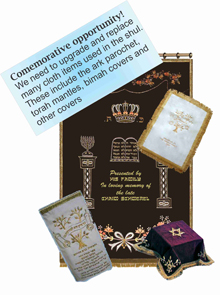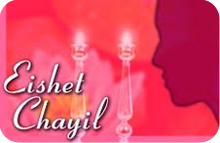THE JEWISH WEDDING CEREMONY
A traditional Jewish wedding is full of meaningful rituals, giving expression to the deepest significance and purpose of marriage. These rituals symbolize the beauty of the relationship of husband and wife, as well as their obligations to each other and to the Jewish people. In preparing for the wedding, the Chatan(Hebrew for Groom) and Kalah( bride) should not only pay attention to the material and temporal aspects of married life, but should focus as well on ensuring religious, spiritual and moral readiness for the future. The following guide explains the Jewish wedding traditions to help you better understand the beauty and joy of the celebration.
In Jewish tradition, a wedding, like other ceremonies celebrating the cycles of life, holds a duality of meaning. It is both a joyous occasion filled with song and dance, and a solemn one when history is remembered and perpetuated and a legal binding commitment is made. The marriage of a bride (kalah) and groom (chatan) who according to Jewish tradition have the status of a king and queen on their wedding day – is referred to in Hebrew as Kiddushin, which means sanctification. Sanctification, too, is a concept both joyous and solemn.
THE WEDDING DAY -PRIVATE YOM KIPPUR
The holiest day of the Jewish year is Yom Kippur, the Day of Atonement. It is a fast day on which each Jew introspectively reviews his or her actions of the past year and does penance for the sins which he or she wittingly or unwittingly committed. For the bride and groom, the day of their wedding is considered a private Yom Kippur. On this special day, the chatan and kalah will fast until they are married. As on Yom Kippur abstaining form food is an act of contrition for past sins, helping them enter their marriage cleansed of the past. A wedding day is considered the beginning of a new life, a fresh slate.
The chatan often wears a kittle, the traditional white robe worn on Yom Kippur. The fast is from dawn until after the completion of the marriage ceremony.
There are occasions when a chuppah takes place and no fasting is required. The Rav will explains this to you in the pre marriage lessons you will have with him.
KABBALAT PANIM
It is customary for the chatan and kalah not to see each other for the week preceding the wedding. Separate receptions are held just prior to the wedding ceremony. Jewish tradition likens the couple to a king and queen. The kalah will be seated on a thrown and receive her guests, while the chatan is surrounded by guests who sing and toast him. At this time there is a tradition for the two mothers to stand together and break a plate. The reason is to show the seriousness of the commitment – just as a plate can never be fully repaired so too a broken relationship can never be fully repaired.
SIGNING OF THE KETUBAH
The Katonah is one of the oldest and least romantic elements of Jewish weddings. It is a legal document pure and simple, a binding chronicle of confidence and trust which details the husband’s obligations to his wife. In the ketubah, the chatan will pledge to ‘honor support and maintain the kalah, in accordance with customs of Jewish husbands’. The signing and accepting of the Ketubah shows that the bride and groom see marriage not only as a physical and emotional union but also as a legal and moral commitment.
Before the ketubah can be signed however the groom and both of the witnesses must make a kinyan – the traditional method by which an agreement is considered binding. The Rabbi or one of the witnesses gives the groom an item such as a handkerchief. By accepting it the groom indicates that he is willing to assume the obligations stipulated in the Ketubah. It will then be up to the Kalah to willingly accept the proposal of marriage. It will be later given to her as a surety of her rights and the chatan’s duties. It becomes her possession not “theirs”.
Not everyone can be a witness for the ketubah. A person needs to be a kosher witness and cannot be related to the bride or groom. The rabbi will explain this to you during your sessions before the wedding.
THE BEDEKKIN
Next comes the beddekin, the veiling of the kalah by the chatan. The veil symbolizes the idea of modesty and conveys the lesson that however attractive physical appearance may be the soul and character are paramount. The bedekkin may have originated in the biblical story of Jacob who thought he was marrying Rachel but not having seen her before the ceremony discovered that he had married Leah her sister. The custom therefore arose for the groom to look at the brides face before the ceremony. The chatan accompanied by family and friends proceeds to the kalah’s room and places the veil over her face. This is an ancient custom and serves as the first of many actions by which the groom signals his commitment to clothe and protect his wife. It is reminiscent of Rebecca covering her face before marrying Isaac.
It is also customary for either the Rabbi or the Kallahs parents to bless the bride.
THE CHUPPAH
The wedding ceremony takes place under the Chuppah (canopy) a symbol of the home to be built and shared by the couple. It is open on all sides just as Abraham and Sara had their tent open on all sides to welcome guests in unconditional hospitality. The chuppah can be held outside under the stars as a sign of the blessing given by G-d to the Patriarch Abraham that his children shall be as the starts of the heavens. The chatan and kalah wear no jeweler under the chuppah. Their mutual commitment to one another is based on who they are as people not on their respective material possessions. The chatan followed by the kalah are usually escorted to the chuppah by their respective sets of parents. Under the chuppah the kalah circles the chatan 7 times. Just as the world was created in seven days the kalah is figuratively building walls of the couple’s new home. The number 7 also symbolizes the wholeness and completeness that they cannot attain separately. The kalah then settles at her chatan’s right hand side.
THE FIRST BLESSINGS – BIRKAT KEDUSHIN (Also referred to as Birkat Eirusin)
Two cups of wine are used in a wedding ceremony. The first cup accompanies the betrothal blessing and after these are recited the couple drinks from the cup. Wine, a symbol of joy in Jewish tradition, is associated with the Kiddush. Marriage which is called Kiddushin is the sanctification of a man and woman to each other.
GIVING OF THE RING
The ring should be made of plain gold without blemishes or ornamentations (e.g. stones) – just as it is hoped that the marriage will be one of simple beauty. The Chatan now takes the wedding ring in his hand and in clear view of two witnesses he declared to his bride “Behold you are betrothed unto me with this ring according to the laws of Moses and Israel”. He then places the ring on the forefinger of the bride’s right hand. According to Jewish law, this is the central moment of the wedding ceremony and the couple is now fully married at this point.
The ring must be purchased by the chatan with his own money. One may not use a ring which is a family heirloom. Although the kalah may purchase the chatan a ring this cannot be handed to the chatan as part of the ceremony.
READING OF THE KETUBAH (The marriage Document)
Now comes the reading of the Ketubah in the original Aramaic text. In marriage the chatan accepts upon himself certain marital responsibilities which are detailed in the ketubah. His principal obligations are to provide food, shelter and clothing for his wife and to be attentive to her emotional needs. The protection of the rights of a Jewish wife is so important that the marriage may not be solemnized until the contract has been completed. The document is signed by two witnesses and has the standing of a legally binding agreement. The ketubah is the property of the Kalah and he must have access to it throughout their marriage. It is often written decoratively to be displayed in the home. The reading of the Ketubah acts as a break between the first part of the ceremony, Kiddush in (betrothal) and the later part nissuin (marriage).
BIRKAT NESUIN – THE SEVEN MARRIAGE BLESSINGS – SHEVA BRACHOT
Nesuin ‘Nuptials’ is the second part of the Jewish wedding ceremony. It is composed of the sheva brachot and yichud (seclusion – the symbolic consummation). The sheva brachot comprise the bulk of the wedding liturgy yet only the last two have anything to say about weddings or brides and grooms. They acknowledge G-d as the creator of the universe who forms man and woman in order that together they may perpetuate life. One interesting blessing reflects that Adam and Eve enjoyed perfect loving companionship in the Garden of Eden, and it is anticipated that the bride and groom will find similar loving companionship with one another.
BREAKING THE GLASS
A glass is now placed on the floor and the chatan shatters it with his foot. This act serves as an expression of sadness at the destruction of the temple in Jerusalem and identifies the couple with the spiritual and national destiny of the Jewish People. A Jew even at the moment of greatest joy is always mindful of the psalmist’s injunction to set Jerusalem above my highest joy. This marks the conclusion of the ceremony with shouts of mazel tov the chatan and kalah are then given an enthusiastic reception from the guests as they leave the chuppah together and hed towards the yichud room, their temporary private chamber.
YICHUD
The couple are escorted to a private room and left alone for the first time. These moments of seclusion signify the newly acquired right of the chatan and kalah to live together as husband and wife. Since the couple has been fasting since the morning at this point they break their fast.
THE FESTIVE MEAL (Seudat Mitzvah)
All now participate in the mitzvah of “lesameyach chatan vekalah” to bring joy to the chatan and kalah. The meal has a status of a seudat mitzvah (a meal associated with a mitzvah) Similar to the meal at the brit milah. After the meal the sheva brachot are recited after the Birkat Hamazon.







